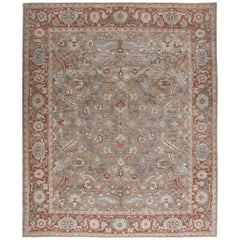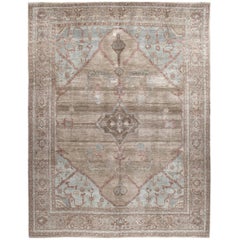Persian Handknotted Bakshaish
2010s Persian Bakshaish More Carpets
Wool
2010s Persian Bakshaish More Carpets
Wool
2010s Persian Bakshaish More Carpets
Wool
2010s Persian Bakshaish More Carpets
Wool
2010s Persian Bakshaish More Carpets
Wool
Nasiri for sale on 1stDibs
Best known among Persian rug collectors for its high-quality luxury rugs, Nasiri specializes in hand-weaving contemporary and mid-century modern designs using old-world techniques.
Nasiri was founded by Nader Nasiri, who initially restored and sold antique Persian rugs from the local bazaar in his native Tehran. After moving to the United States, Nasiri founded his company, intending to introduce traditional Persian carpets to contemporary American life.
Although the firm started by focusing on time-honored Persian carpet-making techniques, Nasiri expanded its collection to include a wide spectrum of diverse weaving techniques. For instance, the company has a selection of Central Asian rugs with designs inspired by the ancient kilims (pileless, flatweave rugs) native to the Kurdish region of Afghanistan. Nasiri also has carpets made with hand-woven techniques found throughout Africa, Turkish rugs and Kalach flatweave rugs featuring Navajo and Scandinavian modern designs.
Nasiri’s Mazandaran collection features centuries-old weaving techniques used by Persian women in northeast Iran. The Mazandaran rug was only recently brought to widespread attention due to its being created solely for domestic use and as a traditional bridal dowry.
Nasiri’s rugs have been featured in numerous publications, including Interior Design, Elle Decor, Architectural Digest and Luxe. Its carpets are highly sought after by leading interior designers, architects and avid Persian rug collectors.
On 1stDibs, discover a range of contemporary Nasiri rugs and carpets.
Finding the Right area-rugs-carpets for You
Antique, new and vintage area rugs and carpets are a simple way to add warmth and style to any space. Area rugs can be seasonal or changed with other decorative objects to refresh an interior. Carpet piles materials can vary from wool and cotton to silk and synthetic fibers, and the purpose of a floor covering can range from reducing noise to offering a place to sit.
Vintage rugs can ground a space, and arranging furniture around them creates a measured focal point. Key furniture pieces can be placed on the rug or just the legs, such as with furniture like coffee tables in your living room.
So, how can you tell if a rug is high quality or vintage?
The three main components that determine the quality of a piece are the dyes, the wool and the number of knots per square inch. Ultimately, however, if you want to be sure the rug you’re buying is truly an antique, it is best to consult an expert.
If you want a creative design that stands out, area rugs or carpets can provide layers of color. Rugs and carpets reflect a global heritage of textiles and weaving, such as ornately patterned Persian and Indian designs. Visually striking Chinese rugs can add a delicate touch of color, while modern rugs make a statement with their geometric patterns.
Turkish rugs, with their ruby reds and misted blues, their entwined botanical designs and rhythmic geometries, are as beloved today as they were in the 13th century. The West’s current infatuation with Moroccan and North African tribal rugs stretches to the mid-20th century, when modern furniture designers embraced bold geometric patterns and even bolder palettes as counterpoints to form-follows-function interiors. Alvar Aalto, Frank Lloyd Wright and Le Corbusier were among the designers who used these rustic, natural rugs to offset austere interiors.
If you properly maintain your antique and vintage rugs, they will last for many years. When you’re thinking about how to clean a rug, it is important to keep in mind that your vacuum is not too harsh for your favorite floor covering. Frequent vacuuming is in fact necessary to remove everyday dirt that otherwise wears down the pile. Omri Schwartz of Nazmiyal does, however, stipulate that “it’s best to use an ordinary suction vacuum without bristles, as the bristles can damage the rug’s pile.” Rotating the carpet every couple of years is also recommended — it ensures that the rug gets even foot traffic.
On 1stDibs, find a vintage rug or carpet to add a layer of beauty and function to your room.




